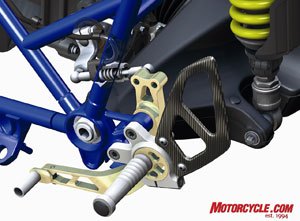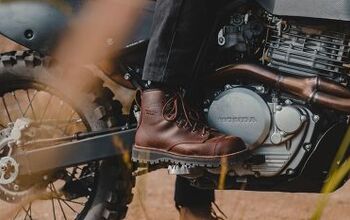First Look: 2008 BMW HP2 Sport - Motorcycle.com
BMW Motorrad is a company that seems to have perfectly mastered leveraging a single engine platform into numerous models. A clear illustration is the G650 X series (Xcountry, Xchallenge and Xmoto) introduced in the spring of this year.
With the exception of the K1200LT, an even more robust use of one platform can be found in the K1200 series with the K1200GT, K1200S, K1200R and K1200R Sport. All use the same engine that shares basic dimensions with minor tweaks and tuning adjustments that yield different torque and horsepower figures best suited for each model's intended uses.
It should come as no surprise then to learn that BMW Motorrad has recently expanded its high-performance Boxer line (HP2) to include a racy street model called the HP2 Sport. The first machine in this growing family was the high-flying HP2 Enduro. Built to take on as much of a dirty environment as you can throw at it, we all marveled at seeing this 400 pound Boxer sail over motocross jumps. Next up was the HP2 Megamoto. With 17-inch wheels, sticky tires and long-travel suspenders, the Megamoto has hooligan written all over it just like a true supermoto, save for the fact that it weighs in excess of 400 lbs.
This latest member of the high-performance family draws its lineage from the endurance-racing-proven R1200S that won its class at Le Mans this year. BMW claims the HP2 Sport produces 128 hp at 8750 rpm and 84.8 ft-lbs of torque at 6000 rpm with a max rev of 9500 rpm, heralding these figures as more spunk than "the significantly modified engine of the BMW R1200S." We don't know if that's how BMW thinks of the mill in the R1200S, but according to them it churns out a claimed 122 bhp at 8250 rpm and 83 ft-lbs at 6300 rpm in standard trim.
The key difference in the Sport's engine are hopped-up cylinder heads that use a drag lever to open and close valves larger than those found in the R1200S. More performance mods include flowed intake and outlet ports, forged pistons, and "adapted" ("beefed-up" in Motorcycle.com speak) connecting rods, all meant to cope with those higher output figures mentioned above.
More ponies and twisting force are complimented with an all-new stainless-steel exhaust system "placed below the engine for the first time." We're not sure what BMW is saying here since a side by side comparison of a front view of an R1200S and the HP2 Sport reveals that the HP2's head pipes tuck in a skosh more than those on the R. Otherwise, the header-pipe configuration looks remarkably similar to that of the S, but cleanly integrated into the tailsection is a sweet-looking muffler canister that is a major improvement over the breadbox on the R1200S. In any event, BMW explains that the purpose of the altered position of the headers is to allow more room to hang off, racer-like. Concealing much of the exhaust is a carbon-fiber/Kevlar chin fairing. As a matter of fact, CFK is scattered across the bike. For example all of the bodywork, and cylinder head covers are crafted out of the carbon fiber/Kevlar composite.
Another item on the HP2 Sport to identify its racing bias is what BMW calls the "the gearshift assistant." This bit of wordsmith trickery translates into what is a type of ignition interrupt that allows the rider keep the throttle pinned whilst snicking up through the close-ratio six-speed gear-set, as used for several years on the roadracing circuit. BMW says it enables "fast gear changes without having to ease off the gas and operate the clutch," and that "this technology is offered for the first time in a series vehicle."
If you intend to race this bike, you'll most likely make the wise move of using a reverse shift pattern, and for just such an application BMW offers (at an additional charge of course), a "suitable replacement pressure sensor" to adapt the quick-shifter to a GP-style race pattern. The forged-aluminum footpegs are adjustable.
A quick scan of the chassis shows fully-adjustable Öhlins shocks keeping the rear Paralever and front Telelever in check. What isn't quite as obvious at first glance is just how minimal the frame is. It's really nothing more than a small collection of tubular steel to hang the engine from and to provide a place for the bodywork and fuel tank to bolt to. Lacking a traditional subframe, the Sport utilizes a self-supporting carbon rear structure as a perch for the rider’s hiney.
Braking is handled by radially mounted four-piston monoblock Brembo calipers and Magura brake levers with radial-pump master cylinders attached to the adjustable handlebars. As an option, BMW ABS can be had, the version for this bike coming with a switch to disable it for track time, or any other time for that matter.
The German bike maker claims that the instrument cluster comes "directly from MotoGP sport" offering the usual ton o' data along with a lap timer and "racing relevant data."
Finally, along with all the carbon bodywork, no subframe and a lighter generator, the HP2 Sport rolls on lightweight forged-aluminum wheels to achieve its claimed dry weight of 392 lbs, and a tank-full (90%) weight wet of 439 lbs. That’s a savings of a significant 27 pounds over the standard R1200S.
So, at this point in time that's about all we know on the latest addition to the HP2 family. Beyond the details that we're not privy to, a couple other things we don't know is if it'll be coming to U.S. shores, and when, exactly, in 2008 it will be available.
One thing we can be certain of, in typical BMW fashion, the HP2 Sport will probably be expensive! Expect a price north of 20 grand.
More by Pete Brissette
































Comments
Join the conversation